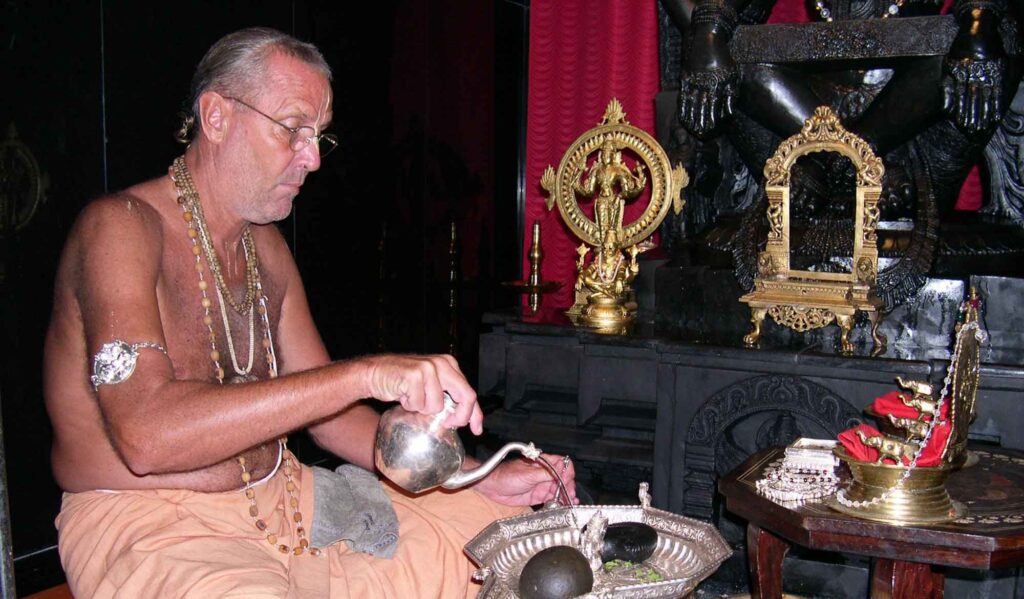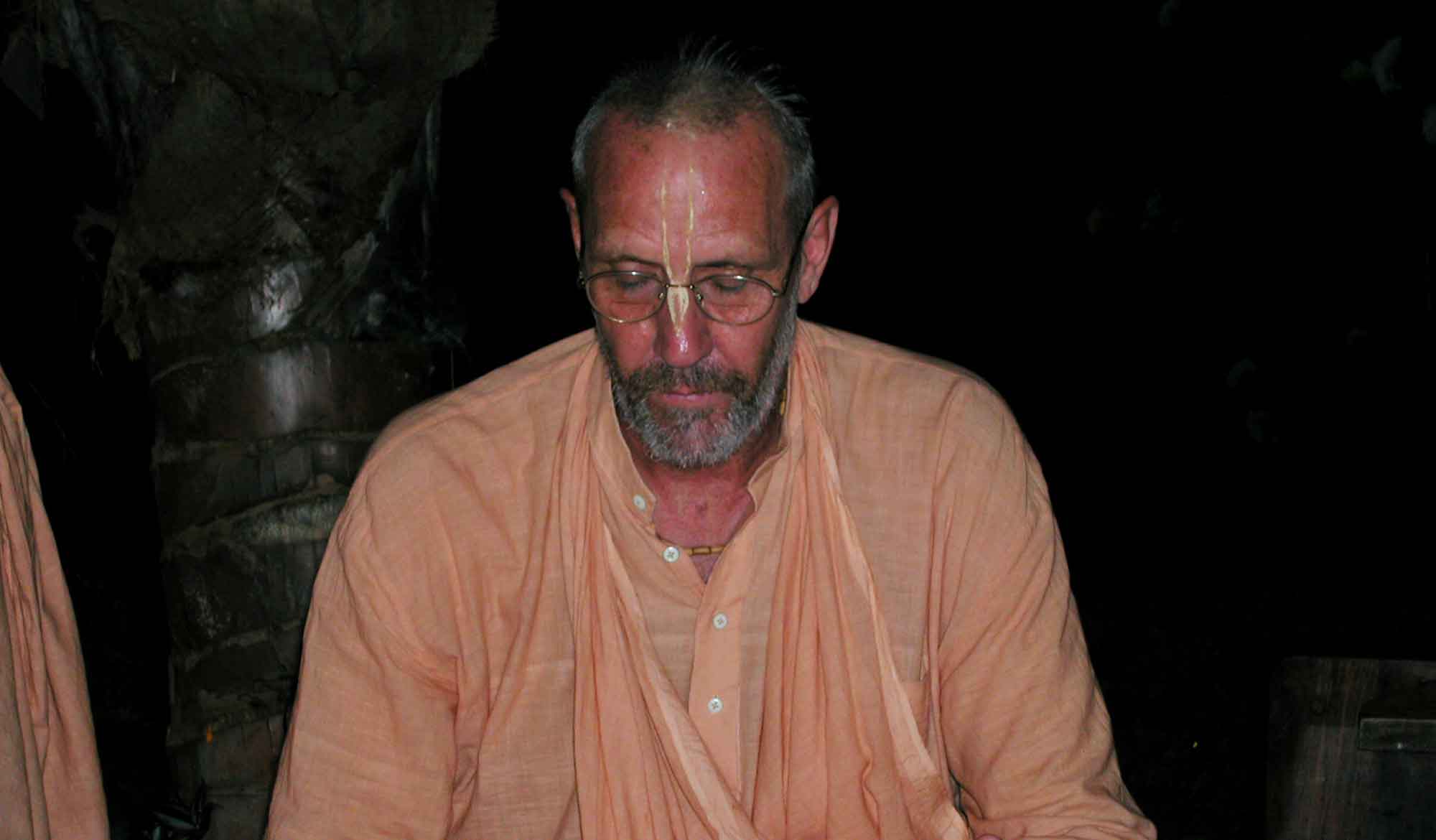by Swami B.G. Narasingha
Sādhu Saṅga’ is an unfinished article written by Swami B.G. Narasingha in 1998. Here, Swami Narasingha explains the prime necessity of associating with advanced sādhus in order to make advancement.
Invoking Auspiciousness
vande śrī-kṛṣṇa-caitanya-devaṁ taṁ karuṇārṇavam
kalāv apy ati-gūḍheyaṁ bhaktir yena prakāśitā
“I offer my respectful obeisances unto Śrī Caitanya Mahāprabhu. He is an ocean of transcendental mercy, and although the subject matter of bhakti-yoga (pure devotional service) is very confidential, He has nonetheless manifested it so nicely, even in the age of Kali, the age of quarrel.”
jaya jaya śrī caitanya, jaya nityānanda
jayādvaita-candra jaya gaura-bhakta-vṛnda
“All glories to Śrī Caitanya Mahāprabhu! All glories to Śrī Nityānanda Prabhu! All glories to Śrī Advaita Ācārya! All glories to all the devotees of Śrī Caitanya Mahāprabhu!”
sādhu-saṅga kṛṣṇa-bhakti-janma-mīla
“Association with advanced Vaiṣṇavas is the root cause of awakening pure devotional service.”
When Śrī Caitanya Mahāprabhu traveled through Banares He met Sanātana Gosvāmī. On the banks of the sacred Gaṅgā the Lord instructed Sanātana in detail about the process of pure devotional service.
Sanātana inquired from Śrī Caitanya Mahāprabhu about the ultimate goal of life beginning with the question, ke āmi — “Who am I?” Mahāprabhu replied to Sanātana Gosvāmī:
jīvera svarūpa haya krsnera nitya-dāsa
“It is the living entities constitutional position to be an eternal servant of Kṛṣṇa.”
Śrī Caitanya Mahāprabhu then explained to Sanātana the three principle energies of the Supreme Personality of Godhead known as cit-śakti, jīva-śakti, and māyā-śakti, the internal potency, the marginal potency, and the external potency respectively.
According to the Viṣṇu Purāṇa the cit-śakti and the jīva-śakti are both manifestations of the para-śakti or superior energy and māyā-śakti is the inferior illusory potency of Godhead.
viṣṇu-śaktiḥ parā proktā kṣetra-jñākhyā tathā parā
avidyā-karma-saṁjñānyā tṛtīyā śaktir iṣyate
“The potency of Viṣṇu/Kṛṣṇa which manifest the spiritual world and the jīva-śakti (kṣetra-jña) are both para or superior manifestations of the Lords energy. The third energy of the Lord manifest the relative worlds of illusion and fruitive activity, karma.” (Viṣṇu Purāṇa 6.7.61)
The same Viṣṇu Purāṇa states however that the jīva-śakti although belonging to the superior energy of Godhead is nonetheless prone to illusion and can be covered by māyā.
yayā kṣetra-jña-śaktiḥ sā veṣṭitā nṛpa sarva-gā
saṁsāra-tāpān akhilān avāpnoty atra santatān
“The living entity (kṣetra-jña-śakti) Although having the facility to live in either the material or spiritual world, suffers the threefold miseries of material existence because he is influenced by the avidyā (ignorance) potency, which covers his constitutional position.” (Viṣṇu Purāṇa 6.7.62)
From time immemorial the living entity entangled in material existence is forgetful of Kṛṣṇa. Due to the living entities forgetfulness of Kṛṣṇa he is suffering the three fold miseries of material existence. In material life the living entity is sometimes wandering in the heavenly planets and sometime he is found wandering in the hellish planets. In all conditions of material life the living entity is forced to suffer the reactions for his pious and impious activities, life after life. That is the sum total of the materially conditioned life of the living entity in forgetfulness of Kṛṣṇa.
When the materially conditioned living comes in contact with a sādhu (a saintly person) who is preaching Kṛṣṇa consciousness by the mercy of that sādhu the conditioned soul becomes liberated from material bondage.
sādhu-śāstra-kṛpāya yadi kṛṣṇonmukha haya
sei jīva nistare, māyā tāhāre chāḍaya
“If the conditioned soul becomes Kṛṣṇa conscious by the mercy of saintly persons who voluntarily preach scriptural injunctions and help him to become Kṛṣṇa conscious, the conditioned soul is liberated from the clutches of māyā, who thus gives him up.”
Contact with a real sādhu (guru) is a rare opportunity for the living entity in material conditioning because by such contact one gets the seed of bhakti, pure devotional service.
brahmāṇḍa bhramite kona bhāgyavān jīva
guru-kṛṣṇa-prasāde pāya bhakti-latā-bīja
“According to their karma, all living entities are wandering throughout the entire universe. Some of them are being elevated to the upper planetary systems, and some are going down into the lower planetary systems. Out of many millions of wandering living entities, one who is very fortunate gets an opportunity to associate with a bona-fide spiritual master by the grace of Kṛṣṇa. By the mercy of both Kṛṣṇa and the spiritual master, one such person receives the seed of the creeper of pure devotional service.” (CC Madhya-līlā 19.151)
We find that Śrī Caitanya Mahāprabhu has given great emphasis to the necessity of associating with a sādhu, a pure devotee of Kṛṣṇa.
sādhu-saṅga sādhu-saṅga sarva-śāstre kaya
lava-mātra sādhu-saṅge sarva-siddhi haya
“The verdict of all revealed scriptures is that by even a moments association with a pure devotee, one can attain all success.”
The value of association with the pure devotee of Kṛṣṇa cannot be compared to anything in this world. Power, wealth, name, and fame – heaven itself or even liberation pale in comparison to the benediction one receives when associating with a sādhu. Only through the association of a sādhu can one gain entrance into the plane of Kṛṣṇa consciousness.
There are three divisions of devotees classified according to their faith. A devotee whose faith is not very strong, who does not study the sastra and try to understand the actual standard of pure devotional service remains as materialistic devotees. Consequently the materialistic devotee does not show proper respect to the advanced devotees of the Lord. This class of devotees is known as kaniṣṭha or third class devotees.
The third class devotee sometimes accepts the shelter of a spiritual master who is expert in all matters of pure devotional service and thus he is elevated above the stage of kaniṣṭha to that of the madhyama-adhikārī or second class devotee. However, after the disappearance of the spiritual master the disciple sometimes again falls down to become a third class devotee due to lack of association with a sādhu. Therefore, the conclusion is that even for those who have come in contact with a sādhu and undergone the process of dīkṣā (initiation) it remains a necessity to always keep higher association. This will protect the madhyama-adhikārī devotees from falling back into kaniṣṭha consciousness.
A madhyama-adhikārī devotee is described as follows:
śāstra-yukti nāhi jāne dṛḍha, śraddhāvān
‘madhyama-adhikārī’ sei mahā-bhāgyavān
“One who is not very expert in argument and logic based on revealed scriptures but who has firm faith (śraddhā) is considered a second class devotee. Such a devotee is also considered most fortunate (mahā–bhāgyavān).”
The madhyama-adhikārī who strictly follows the order of the spiritual master and who does not commit any offence against the holy name of Kṛṣṇa soon becomes an uttama-adhikārī, first class devotee. If, however offences are committed against the holy name then one falls down from the path of pure devotional service and again becomes a materialistic devotee. To guard one’s self against offences to the name one should always keep company with a sādhu. In the association of the sādhu one gets the chance to continuously hear and chant about Kṛṣṇa.
mac-cittā mad-gata-prāṇā
bodhayantaḥ parasparam
kathayantaś ca māṁ nityaṁ
tuṣyanti ca ramanti ca
“The thoughts of my pure devotees dwell in Me, their lives are fully devoted to My service and they derive great satisfaction and bliss from always enlightening one another and conversing about Me.” (Gītā 10.9)
Hearing and chanting about the transcendental name, fame, form, qualities, and pastimes of Kṛṣṇa in association of the sādhu elevates one from the clutches of the material energy and establishes the living entity in his constitutional state of pure consciousness.
A madhyama-adhikārī devotee who always keeps the association of a sādhu gradually develops all good qualities. Indeed, all the good qualities of Kṛṣṇa gradually develop in Kṛṣṇa’s devotee. When one comes to the stage of an uttama-adhikārī there are twenty-six transcendental qualities automatically manifest in his character. These are as follows:
kṛpālu, akṛta-droha, satya-sāra sama
nidoṣa, vadānya, mṛdu, śuci, akiñcana
sarvopakāraka, śānta, kṛṣṇaika-śaraṇa
akāma, anīha, sthira, vijita-ṣaḍ-guṇa
mita-bhuk, apramatta, mānada, amānī
gambhīra, karuṇa, maitra, kavi, dakṣa, maunī
“Pure devotees are always merciful, humble, truthful, equal to all, faultless, magnanimous, mild and clean. They are without material possessions, and they perform welfare work for everyone. They are peaceful, surrendered to Kṛṣṇa and desireless. They are indifferent to material acquisitions and are fixed in devotional service. They are completely control the six bad qualities – lust, anger, greed, and so forth. They eat only as much as required, and they are not inebriated. They are respectful, grave, compassionate and without false prestige. They are friendly, poetic, expert, and silent.”
titikṣavaḥ kāruṇikāḥ
suhṛdaḥ sarva-dehinām
ajāta-śatravaḥ śāntāḥ
sādhavaḥ sādhu-bhūṣaṇāḥ
“Pure devotees are always tolerant, forbearing and very merciful. They are the well-wishers of every living entity. They follow the scriptural injunctions, and because they have no enemies, they are very peaceful. These are the decorations of pure devotees.”
There is no stage of advancement in Kṛṣṇa consciousness where in the association of a sādhu is not desirable. In the neophyte stage one awakens his dormant love for Kṛṣṇa by association with a sādhu and in the advances stage of Kṛṣṇa consciousness a pure devotee keeps association with other sādhus in order to taste the mellow sweetness of love of God.
kṛṣṇa-bhakti-janma-mūla haya ‘sādhu-saṅga’
kṛṣṇa-prema janme, teṅho punaḥ mukhya aṅga
“The root cause of pure devotional service to Lord Kṛṣṇa is association with advanced devotees. Even when one’s dormant love for Kṛṣṇa awakens, association with advanced devotees is still most essential.”
In this regard we may site the example of Śrī Caitanya Mahāprabhu who always kept the association of His devotees like Rāmānanda Rāya and Svarūpa Dāmodara.
More Articles by Swami B.G. Narasingha
The Sacred River Sindhu/Indus
‘The Sacred River Sindhu/Indus’ was posted by Swami B.G. Narasingha on his blog, narasingha.net, on October 2nd, 2011. In this short article, Narasingha Maharaja explains the significance of the River Sindhu and his pilgrimage to it. This article was later expanded into a bigger article called ‘Sindhu River – How India Got Her Name.’
Instructing the Guru
This article “Instructing the Guru” was written in April 2018 by Śrīla Narasingha Mahārāja who answers a question concerning a previous article wherein a Vaiṣṇavī writes a letter to her dīkṣā-guru and explains to him about the importance of śikṣā. In response, a question was raised by a devotee about the etiquette of a disciple instructing her guru.
The Atomic Ray – From Uniform Consciousness to Individual Conscious Units
In “The Atomic Ray - From Uniform Consciousness to Individual Conscious Units” written in 1996 Śrīla Narasiṅgha Mahārāja discusses the constitutional position of the jīva, according to Bhaktivinoda Ṭhākura and Śrī Caitanya-caritāmṛta.













